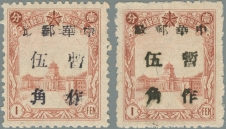Chengde (承德) – Date of Liberation: 1st time 19 August 1945 – August 1946, 2nd time 12 November 1948
[huge_it_maps id=”19″]
This map only gives rough impression about area and location. Chengde is previously known as Jehol or Rehe.
1st stamp issue (Kerr 23.1, .3, .5 / 23.6, .8, .10):
| Provisional Issue: | Stamps Overprinted and Surcharged (1945) |
| Issued: | October 1945 |
| Issued by: | Reorganization Committee of Rehe Post (熱河郵政整理委員會) in Chengde (承德) |
| Overprint: | “Chinese Posts – Temporarily Used for” and Surcharged (“中華郵政暫作” 改值郵票) |
| Print: | Machine-overprinted with types |
| Currency: | Shanxi-Chahar-Hebei Currency (冀熱遼邊幣) |
| Valid until: | April 1946 |
All stamps of this issue shown here.
2nd stamp issue (Kerr 23.2, .4 / 23.7, .9):
| Provisional Issue: | Stamps Overprinted and Surcharged (1946) |
| Issued: | February 1946 |
| Issued by: | Rehe Proviencial Postal Administration (熱河省郵政管理局) |
| Overprint: | “Chinese Posts – Temporarily Used for” and Surcharged (“中華郵政暫作” 改值郵票) |
| Print: | Machine-overprinted with types |
| Currency: | Shanxi-Chahar-Hebei Currency (冀熱遼邊幣) |
| Valid until: | April 1946 |
All stamps of this issue shown here.
Both sets are listed in most major Liberated Area stamp catalogs.
Remarks:
– I don’t know who started first to put both issues into one set and later split them into two sets separated by more or less oily overprints, but this can’t be correct because you can find during a period of at least six months the stamps were overprinted all kinds of nuances of more or less oily stamps. I believe the overprint was made by types by a machine which was manually operated. After some turns of overprints, the staff cleaned the machine using some oily clothes and restart to overprint the stamps. As the result the first rounds got an oily impression which got weaker over the time ends up in “Hard Black surcharge” and after the end of the day when the machine got cleaned the circle starts again. I can’t prove this these, but many facts support it (like the wide range of less or more oily impressions and the same more or less oily impression over the whole time the stamps were printed. You just can’t make a sharp line between more of less oily impressions. All this speaks there was only one issue with a wide range of more or less oily impressions).
– You can find different overprint settings. Are these two different overprints or just different settings in one sheet? More information is necessary to come to a final conclusion.







